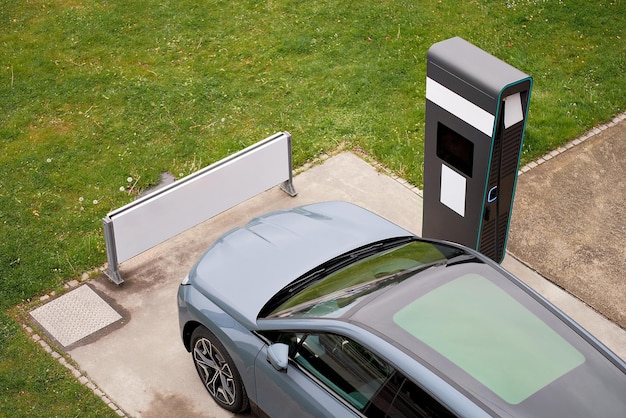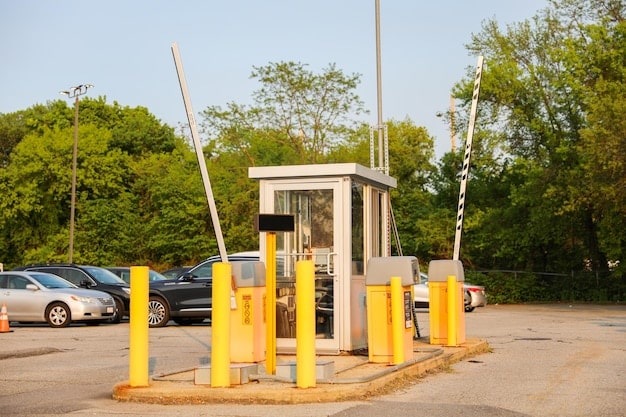The Future of Electric Vehicles: Charging Challenges in the US

The Future of Electric Vehicles: Charging Infrastructure Challenges in the US highlights the pressing need for advancements in charging technology and infrastructure to support the growing adoption of electric cars, focusing on accessibility, speed, and reliability for consumers across the United States.
The future of transportation is increasingly electric, but the road to widespread adoption of electric vehicles (EVs) in the US faces a significant hurdle: charging infrastructure. While EV technology continues to advance, the availability and reliability of charging stations remain a concern. The Future of Electric Vehicles: Charging Infrastructure Challenges in the US needs innovative solutions to overcome range anxiety and make EV ownership a seamless experience for all drivers.
Current State of EV Charging Infrastructure in the US
The current state of electric vehicle (EV) charging infrastructure in the United States is a mixed landscape of progress and challenges. While there has been significant growth in the number of charging stations, distribution remains uneven, and availability varies drastically between states and urban versus rural areas.
Understanding the existing infrastructure is crucial to identifying the gaps that need to be addressed to support the widespread adoption of EVs. This involves examining the types of charging stations available, their distribution across the country, and the challenges faced by both EV owners and charging station operators.
Types of Charging Stations
There are primarily three levels of EV charging:
- Level 1 Charging: Uses a standard 120V household outlet, providing the slowest charging speed (adding about 4-5 miles of range per hour).
- Level 2 Charging: Uses a 240V outlet, like those used for appliances. It significantly increases charging speed (adding about 20-30 miles of range per hour).
- DC Fast Charging (Level 3): Uses high-voltage DC power, providing the fastest charging speeds (adding up to 200 miles of range per hour).
Distribution and Availability
The availability of charging stations varies significantly across the US. States with strong incentives and supportive policies, like California, tend to have a more robust charging network. However, many states, particularly in rural areas, still lack adequate charging infrastructure, leading to range anxiety for potential EV buyers.
This uneven distribution presents a significant challenge. For EVs to be a viable option for all Americans, charging infrastructure needs to be accessible to all, not just those living in urban centers.
In conclusion, while progress has been made, the current state of EV charging infrastructure in the US still faces significant challenges. Uneven distribution, limited availability, and concerns about reliability are all factors that need to be addressed to support the widespread adoption of EVs.
Challenges in Expanding Charging Infrastructure
Expanding the electric vehicle (EV) charging infrastructure in the US is not without its challenges. Several key issues hinder the rapid deployment of charging stations, from high costs and technological limitations to regulatory hurdles and public perception challenges.
Overcoming these challenges is essential for creating a robust and reliable charging network that can support the increasing number of EVs on the road. It requires a multi-faceted approach involving government incentives, private investment, technological innovation, and public education.

High Costs of Installation and Maintenance
The cost of installing and maintaining EV charging stations can be substantial. DC fast chargers, in particular, require significant upfront investment due to their high power output and specialized equipment.
Technological Limitations
Current charging technology still has limitations. Charging speeds can vary depending on the EV model and the charging station’s capabilities.
Regulatory Hurdles
Navigating the regulatory landscape can be complex. Zoning regulations, permitting processes, and building codes can vary significantly between municipalities, creating delays and increasing costs for charging station operators.
- Streamline permitting processes.
- Offer incentives for charging station installation.
- Develop clear and consistent standards for charging infrastructure.
In conclusion, expanding EV charging infrastructure requires overcoming numerous challenges, including high costs, technological limitations, regulatory hurdles, and public perception issues. Addressing these challenges through innovative solutions will be critical to creating a reliable and accessible charging network that supports the widespread adoption of EVs.
Government Incentives and Policies
Government incentives and policies play a crucial role in driving the adoption of electric vehicles (EVs) and expanding the charging infrastructure across the United States. These initiatives aim to reduce the upfront cost of EVs, encourage the installation of charging stations, and support research and development in charging technology.
Understanding the types of incentives and policies available, as well as their impact on the EV market, is essential for both consumers and businesses looking to invest in EVs and charging infrastructure. These policies can range from tax credits and rebates to grants and regulatory measures.
Federal Tax Credits and Rebates
The federal government offers tax credits for the purchase of new EVs. These credits can significantly reduce the upfront cost of owning an EV, making them more accessible to a wider range of consumers.
State and Local Incentives
Many states and local governments offer additional incentives to promote EV adoption. These incentives can include rebates, tax credits, and grants for both EV purchases and charging station installations.
- California’s Clean Vehicle Rebate Project (CVRP): Offers rebates for eligible EV purchases.
- New York’s Drive Clean Rebate: Provides rebates for new EV purchases.
- Maryland’s EV Charger Rebate Program: Offers rebates for the installation of EV chargers.
Regulatory Measures
In addition to financial incentives, regulatory measures also play a crucial role in promoting EV adoption and expanding charging infrastructure. These measures can include mandates for EV sales, building codes that require EV charging infrastructure in new construction, and policies that support grid integration of renewable energy sources.
In conclusion, government incentives and policies are essential for driving the adoption of EVs and expanding charging infrastructure in the US. By reducing costs, encouraging investment, and supporting research and development, these initiatives can help accelerate the transition to a cleaner and more sustainable transportation future.
Technological Innovations in Charging
Technological innovations are revolutionizing the electric vehicle (EV) charging landscape, making it faster, more efficient, and more accessible. These innovations include advancements in charging speeds, wireless charging, battery technology, and smart grid integration.
Exploring these technological breakthroughs is crucial for understanding the future of EV charging and how they will impact the widespread adoption of EVs. These innovations will not only improve the charging experience for EV owners but also make charging infrastructure more sustainable and reliable.

Fast Charging Technologies
Fast charging technologies, such as DC fast charging (DCFC), are significantly reducing charging times for EVs. These technologies can add up to 200 miles of range in just 30 minutes.
Wireless Charging
Wireless charging is emerging as a convenient and user-friendly alternative to traditional plug-in charging. It uses electromagnetic fields to transfer energy from a charging pad to an EV without the need for cables.
Battery Technology Advancements
Advancements in battery technology are also playing a crucial role in improving charging efficiency and range. New battery chemistries, such as solid-state batteries, offer higher energy density, faster charging times, and increased safety.
- Faster charging times.
- Increased range.
- Improved safety.
In conclusion, technological innovations are transforming the EV charging landscape, making it faster, more efficient, and more accessible. By embracing these advancements, we can overcome the challenges of charging infrastructure and accelerate the transition to a sustainable transportation future.
Private Sector Investment and Initiatives
Private sector investment and initiatives are playing a critical role in driving the development and deployment of electric vehicle (EV) charging infrastructure across the US. Companies are investing in charging station networks, developing innovative charging solutions, and collaborating with government agencies to accelerate the transition to electric transportation.
Understanding the scope and impact of these private sector efforts is essential for gauging the overall progress of EV infrastructure development. These investments not only expand the availability of charging stations but also drive innovation and competition in the charging market.
Charging Network Development
Companies like Tesla, Electrify America, and ChargePoint are investing heavily in building and expanding their charging station networks across the US.
Innovative Charging Solutions
Private companies are developing innovative charging solutions to address the diverse needs of EV owners. These solutions include mobile charging units, battery swapping stations, and smart charging technologies that optimize energy consumption.
Partnerships and Collaborations
Private companies are collaborating with government agencies, utilities, and other stakeholders to accelerate the deployment of EV charging infrastructure. These partnerships leverage the strengths of each sector to overcome the challenges of building a comprehensive and reliable charging network.
In conclusion, private sector investment and initiatives are essential for driving the development and deployment of EV charging infrastructure in the US. By investing in charging networks, developing innovative solutions, and collaborating with government agencies, private companies are helping to accelerate the transition to a sustainable transportation future.
Future Outlook and Recommendations
The future of electric vehicle (EV) charging infrastructure in the US looks promising, with continued growth in charging station availability, technological advancements, and policy support. However, realizing the full potential of EVs requires addressing remaining challenges and implementing key recommendations.
Looking ahead, it is crucial to consider how charging infrastructure can be developed to support the increasing number of EVs on the road and ensure that charging is convenient, affordable, and accessible for all drivers. This involves forecasting future demand, planning for grid capacity, and addressing the needs of underserved communities.
- Invest in research and development of advanced charging technologies.
- Promote standardization and interoperability of charging equipment.
- Ensure equitable access to charging infrastructure for all communities.
By addressing these recommendations, the US can create a robust and reliable charging network that supports the widespread adoption of EVs and accelerates the transition to a sustainable transportation future.
| Key Point | Brief Description |
|---|---|
| ⚡ Charging Infrastructure | Addressing the needs of fast, accessible, and reliable EV charging stations is essential. |
| 💰 Cost & Investment | Overcoming the high installation/maintenance costs through government and private investments. |
| 💡 Tech Innovation | Enhancing charging speeds and efficiency through battery technology advancements. |
| 🤝 Collaboration | Focus on partnerships between all branches of companies. |
FAQ
▼
Key challenges include the high costs of installation, uneven distribution, technological limitations, and regulatory hurdles. Addressing these will enhance EV adoption.
▼
Government policies such as tax credits and rebates, combined with private sector investments, promote EV charging infrastructure. This makes it easier for consumers.
▼
Innovations like DC fast charging, wireless charging, and advanced battery tech. These significantly reduce charging times and enhance charging station sustainability.
▼
Private companies invest in charging networks, offering innovative solutions, and collaborating with government. This is essential for broadening charging station availabilty.
▼
The future includes continuous growth, technological improvements. It requires equity in access to charging infrastructure for sustainable transportation options.
Conclusion
In conclusion, the future of electric vehicles in the US hinges significantly on overcoming the challenges associated with charging infrastructure. Strategic investments, policy support, and technological advancements are crucial to creating a reliable, accessible, and sustainable charging network that fuels the widespread adoption of EVs and paves the way for a cleaner transportation future.





